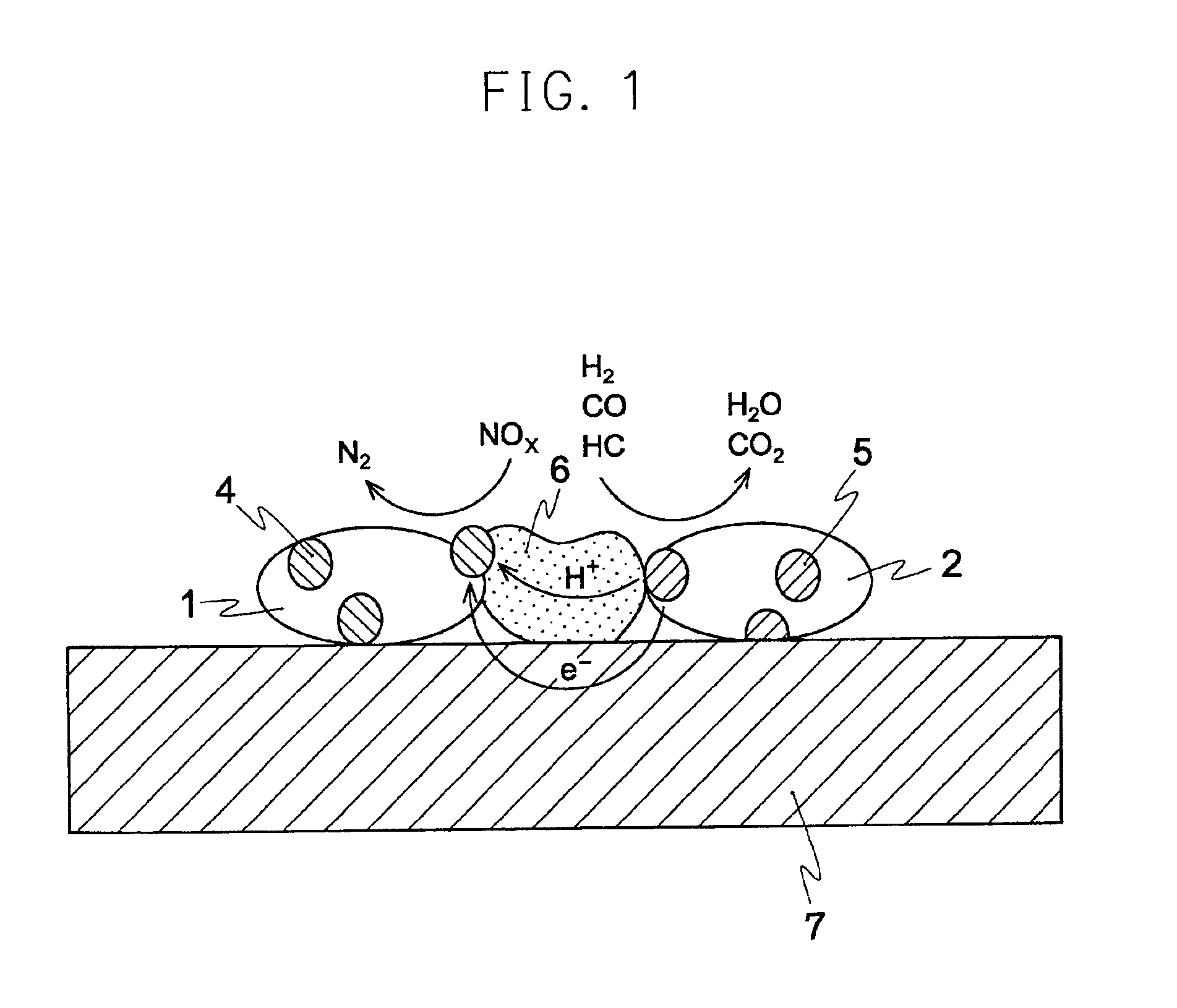Catalyst and process for exhaust purification
a technology of catalyst and exhaust, applied in the direction of metal/metal-oxide/metal-hydroxide catalyst, machine/engine, arsenic compound, etc., can solve the problem of torque shock upon inserting a rich spike, the difficulty of continuously providing hc and co in an amount for sufficiently reducing no/sub>x,
- Summary
- Abstract
- Description
- Claims
- Application Information
AI Technical Summary
Benefits of technology
Problems solved by technology
Method used
Image
Examples
embodiment 1
FIG. 1 is a schematic view that shows a catalyst for exhaust purification in Embodiment 1. In the FIG., 1 represents a catalyst A containing an NOx absorbing substance and an NOx reducing catalyst, 2 represents a catalyst B containing a hydrocarbon (HC) adsorption substance and an HC oxidizing catalyst, 4 represents a particle of noble metal reducing catalyst, 5 represents a particle of noble metal oxidizing catalyst, 6 represents an ion conductive solid electrolyte, and 7 represents a metal honeycomb. Solid-line arrows in the solid electrolyte 6 indicate flow of electrons (e−) and flow of ions (protons: H+). In Embodiment 1, the solid electrolyte 6 deals with only ion conduction and the metal honeycomb 7 deals with electron conduction.
Since the metal honeycomb 7 can maintain a sufficient strength even if it is thinner than a ceramics honeycomb, pressure loss thereof becomes low. Moreover, since it also has advantages such as excellent heat conduction, it is coated with a catalyst f...
embodiment 2
FIG. 3 is a schematic view that shows an electrochemical catalyst for exhaust purification in Embodiment 2.
As the state of ion conduction, Embodiment 2 does not show the proton conduction, but the oxygen ion conduction. In case of the oxygen ion conduction, the reactions of the above-mentioned formulas (1) to (5) are respectively replaced by the reactions shown in the following formulas (6) to (10), but the reactants and the like are basically the same.
[Reducing Electric Potential]
2NO+4e−→N2+2O2− (6)
2NO2+8e−→N2+4O2− (7)
[Oxidizing Electric Potential]
C+2O2−→CO2+4e− (8)
H2+O2−→H2O+2e− (9)
CO+O2−→CO2+2e31 (10)
As the solid electrolyte 6 having ion conductivity, for example, there are perovskite ceramics disclosed in Japanese Unexamined Patent Publication NO. 8-332342 / 1996, and this can be used at an operation temperature and an atmosphere suitable for a catalyst for exhaust purification. Moreover, there may be used a solid electrolyte 6 having electron conductivity and ion conductivi...
embodiment 3
FIG. 4 is a schematic view that shows a catalyst for exhaust purification in Embodiment 3. In this Figure, 1 represents a catalyst A containing an NOx absorbing substance and an NOx reducing catalyst, 2 represents a catalyst B containing a hydrocarbon (HC) adsorption substance and an HC oxidizing catalyst, 3 is a mixture of an electron conductive material C and an ion conductive substance D (solid electrolyte), 4 represents particles of noble metal reducing catalyst, 5 represents particles of noble metal oxidizing catalyst. And solid-line arrows in the solid electrolyte 3 indicate flow of electrons and flow of ions (protons).
Concrete compositions, methods for preparation and evaluation results including Comparative Examples are shown in Examples. In the present Embodiment 3, the basic construction of the present invention wherein protons are used as ion conductor and the reasons for revealing effects are explained in detail by referring to FIGS. 4 and 2.
The mixture of the electron c...
PUM
| Property | Measurement | Unit |
|---|---|---|
| electromotive force | aaaaa | aaaaa |
| electric potential | aaaaa | aaaaa |
| electron conductive | aaaaa | aaaaa |
Abstract
Description
Claims
Application Information
 Login to View More
Login to View More - Generate Ideas
- Intellectual Property
- Life Sciences
- Materials
- Tech Scout
- Unparalleled Data Quality
- Higher Quality Content
- 60% Fewer Hallucinations
Browse by: Latest US Patents, China's latest patents, Technical Efficacy Thesaurus, Application Domain, Technology Topic, Popular Technical Reports.
© 2025 PatSnap. All rights reserved.Legal|Privacy policy|Modern Slavery Act Transparency Statement|Sitemap|About US| Contact US: help@patsnap.com



